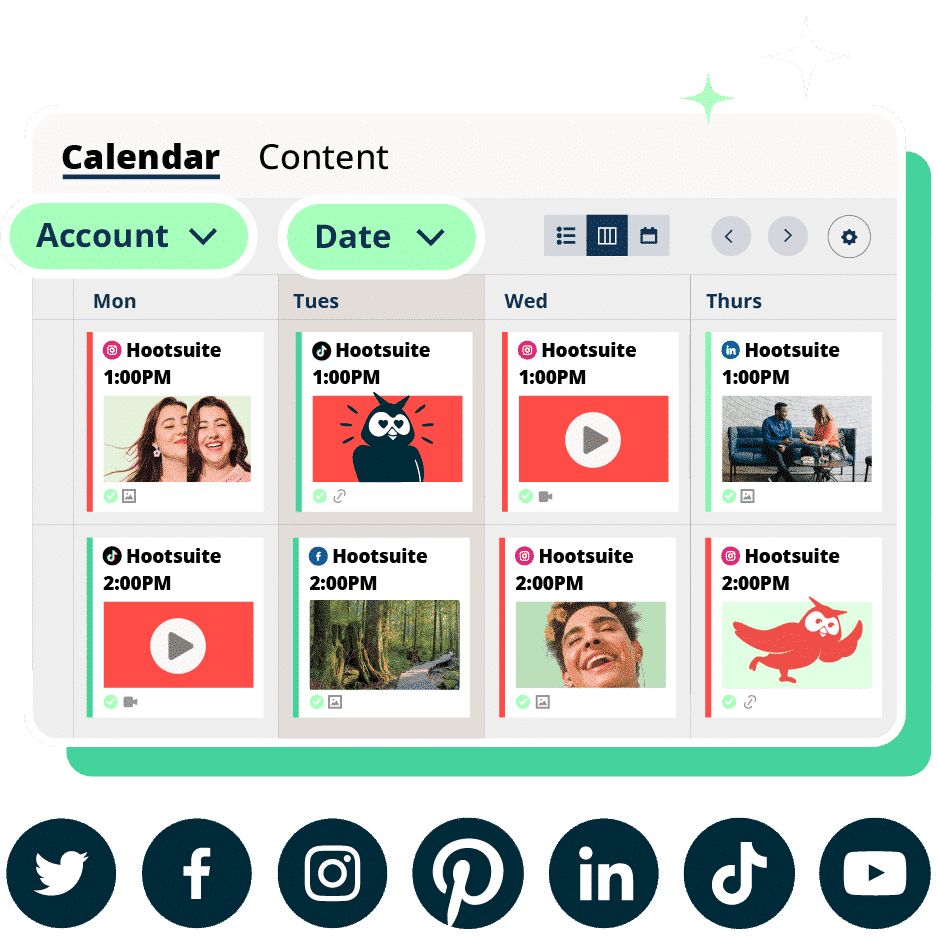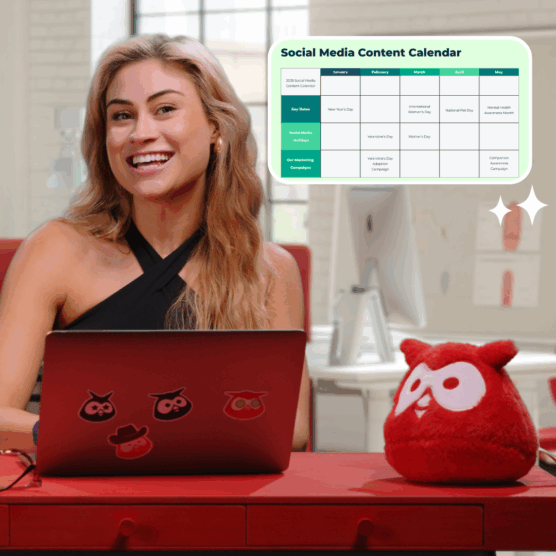It doesn’t matter what an incredible Instagrammer you are or how TikTok-savvy you may be. If you want to win business as a social media marketer, you don’t just need the skills. You need a convincing social media proposal, too.
For solo freelance social media managers and marketing agencies alike, social media proposals are essential for growing your business — so you’d better be prepared to knock it out of the park.
Luckily, we’ve got you covered with this step-by-step guide to creating a social marketing proposal and a free template to help you craft your own in just a few minutes.
A social media proposal is a document that outlines your strategy, goals, and tactics for managing a client’s social media presence.

It serves as a roadmap (beep beep!), helping both you and your client understand the objectives, deliverables, and expected outcomes of your social media marketing strategies.
To kick things off, you’ll need to figure out what those goals are. Then, you can share a game plan for how you’ll help and what success will look like.
A professional social media proposal should also include the dirty details: timeline, deliverables, and budgets.
Throughout the proposal, you’ll also establish your expertise in the field and demonstrate why you’re the right person (or firm) for the job. After all, a social media proposal isn’t just about what a company should do… it’s about who should do it. (You! It’s always been you!)
Your social media proposal is also your chance to outline expectations, promises, and responsibilities right out of the gate so your working relationship with a new client is free from unpleasant surprises.
A social media proposal becomes crucial when you’re aiming to collaborate with clients on developing and executing a strategic social media plan.
Whether you’re a freelance social media manager or part of an agency, having a plan in place is essential. Aim to write a social media marketing proposal before any work gets started.
Integrating the social media proposal into your sales process is key to a seamless collaboration.
It should be presented after initial discussions and consultations with the client, clearly outlining what they can expect from your services. This ensures that both parties are aligned before any work begins.
Identify the client’s needs and problems
What problems are they facing? What needs do they have? Don’t skimp on the detective work here. Go deep and research your client’s industry, target audience, and competitors. Our guide to competitive analysis on social media walks you through this process.
Of course, along with your sleuthing, you’ll want to actually ask your prospects what they think, too. Whether that’s through a discovery call or intake form, get the answers you need straight from the source. (For more details on what questions to ask and where to find the answers, check out our guide to conducting a social media audit.)
That being said, if you’re responding to an RFP (request for proposal) and not dealing directly with your potential client, you might not have the option to grill ’em.
In that case, get familiar with the request doc and use Hootsuite’s social listening features to help you gather valuable insights that will inform your strategy.

Define their business goals and objectives
Clearly outline the objectives and goals of the social media campaign. Keep it simple and specific—you want to leave little room for ambiguity. Luckily, you’ve got all this great research from step one to help you identify both challenges and opportunities.
Specify the objectives of the individual project, as well as the objective of the organization as a whole. After all, any social media campaign will need to align with the client’s overall business objectives and key performance indicators (KPIs).
If you’re responding to an RFP, use language here that echoes the way the organization has defined what they’re looking for.
Set S.M.A.R.T. social media goals
Those business objectives above? They set the stage for your social media goals, which you’re going to share starting… now!
State three to five S.M.A.R.T social media goals. Remember, S.M.A.R.T. goals are strategic, measurable, attainable, relevant and time-bound. (More on S.M.A.R.T. social media goals here!)
Each objective should specify:
- the platform(s) being used
- the metric(s)
- an end date

It needs to be clear when to measure the goal, what the success metric is, and how it ties into the overall brand goals. (For example: Increase Facebook followers by 25 percent by the end of Q4.)
Outline your game plan
It’s time to share your brilliant strategy in detail. What kind of social media services will you provide to support their goals? Make sure to include the platforms you’ll focus on, content types, posting frequency, and engagement tactics.
Remember: everything you pitch should be tied back to those objectives mentioned in the previous section. It’s not just about what you will do, but why. Every action you suggest needs to be connected to a reason.
Your social media strategy and scope of work can cover things like:
- Social media promotions and campaigns
- Content creation
- A strategic publishing schedule
- Social media monitoring
- Social media engagement
- Social selling
- Lead generation
Whatever content is part of your proposal, make it crystal clear what your specific deliverables are.
Are you actually creating and posting TikToks or just providing recommendations for the client team to execute? Make it very clear who does what, and exactly what the client can expect to receive.
Breakdown the timeline and budget
Now that everyone’s excited about the social media scheme you’ve laid out, it’s time to outline when and how you’re going to make it happen.
A schedule can be super detailed, with dates for content development, testing, or analysis. Or maybe it’s just a list of high-level due dates for each deliverable.

(Psst: Download your own version of this timeline in our handy social media proposal template)
Including milestones and check-ins is a good idea to keep everyone happy and informed… and keep you on track.
At this point, it’s also helpful to share a transparent breakdown of the budget and resources required for the campaign. This includes ad spend, content creation costs, and any additional tools or platforms needed… and your fee. (Whether that’s a flat rate or by the hour is up to you and your client to decide.)
Define success
When your big plan pays off, how will you know? It’s important to agree early on what defines success: what will the key performance indicators be?
Outline how you’ll measure the viability of the campaign. (Hot tip: Hootsuite’s analytics tools are an easy way to show your client the real-time impact of your efforts. In your reports, you can compare social metrics over time and even across networks.)

Pro Tip: Leverage Hootsuite’s social listening tools for a standout proposal. Gain insights into prospective clients, their industry, and competitors, and then reference real data in your proposal to demonstrate a deep understanding of the current social media landscape. This personal touch showcases your expertise and builds trust with your potential client. Win-win.
Write an executive summary
This is the first section of your social media proposal, but it’s essentially an overview of the proposal, so we highly recommend writing this part last. After you’ve refined all the other details, it can be easier to understand the most important points to include here.
Think of it as the tl;dr for busy executives. Summarize the need(s) for the proposed project in less than a page. Identify the problem, share the anticipated results, and clarify the budget and resource requirements.
Need an example of a social media proposal? Download our handy social media proposal template now…
…or use the outline below to quickly craft your own professional social media proposal.
Executive summary
- Brief overview of your agency and experience
- Explain the purpose of the proposal
- Summarize the proposed solution
- Share the anticipated results, budget and timeline
Client background info
- Summarize the client’s business goals and campaign goals
- Summary of their current social media presence
Campaign goals and objectives
- Clearly define objectives and goals for the social campaign
Social media strategy
- Detail your plan for executing the campaign
- Propose content types and posting schedule
- Clarify responsibilities
Timeline, budget and resources
- Create a schedule of milestones and deadlines
- Share a breakdown of costs, including ad spend and additional tools
Measurement and analytics
- Outline KPIs
- Define how and when success will be measured
Terms of agreement
- Explain your fees, working style and billing preferences
- Clarify how to terminate the project if it isn’t going well for either party
But remember: this is just one social media proposal sample. Each project and client will require something unique from you with your pitch.
Maybe you like to include “next steps” that clarify what happens after the proposal is sent. Maybe it’s helpful to include examples or case studies of similar work you’ve done for other clients. Use this social media proposal template as your starting point, and add or subtract as you need to.
Use Hootsuite to manage all your social media in one place and save time. Create and schedule posts on every network, track results, engage your audience, and more. Try it free today.








